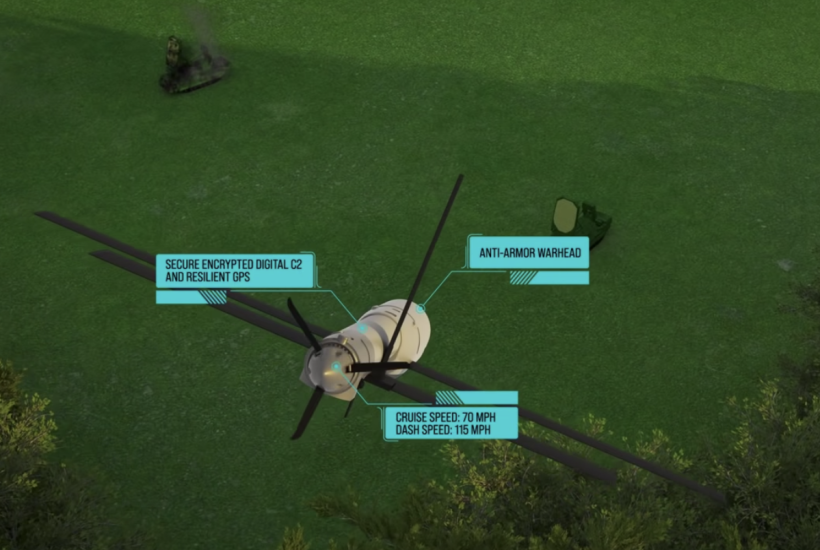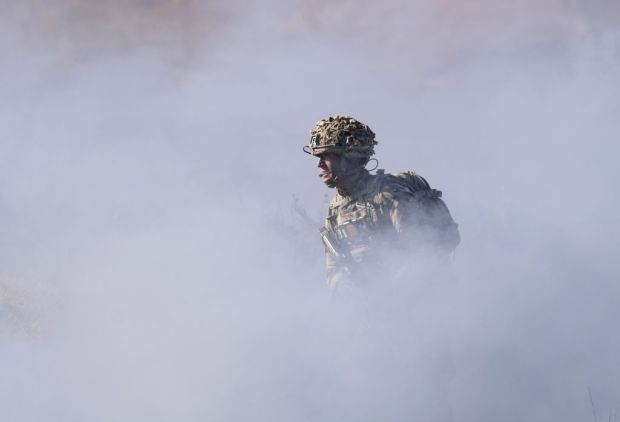The United States is sending a new weapon to Ukraine in the fight against Russia: the Switchblade drone. At least 100 of the loitering munitions (LMs) are being shipped from the US as part of an $800 million (£600 million) package of military aid. Switchblade, which is launched from a tube and is about the size of a baguette, is fitted with an explosive warhead. An operator flies the drone into an area of interest before detecting, identifying and attacking a target with lethal effect. Can it help win the war for Ukraine?
Designed and manufactured by California-based AeroVironment, there are multiple variants of the Switchblade drone. Initially, it seems most likely the Switchblade 300, a smaller variant of the drone, will be sent to Ukraine. With a range of 10km and a maximum flight time of 15 minutes, the drone will enable Ukrainian forces to target Russian troops with precision from a safe distance. Switchblade can be linked up with other intelligence-gathering drones on the battlefield to support the detection and identification of potential targets. Its explosive is roughly equivalent to a 40mm grenade. And while it will not defeat armoured vehicles, its warhead is sufficient to engage infantry and unprotected vehicles.
The Switchblade 300’s big brother, the Switchblade 600, will also be included in the US’s offering to Ukraine. With a range of 90km and a flight time of 40 minutes, the 600 version comes equipped with a much bigger payload: it is armed with the same warhead as the FGM-148 Javelin anti-tank guided missile. This payload uses what is known as the Munroe Effectto destroy tanks. Put simply, it works by using an explosive that is shaped around a hollow metal liner. The metal liner comes in many shapes, such as a cone or tulip, and made of many metals including copper, aluminium, and even something called molybdenum. When the warhead hits the target, the explosive around the cone of metal detonates and rapidly collapses the cone of metal. The force changes the characteristics of the metal, making it act like a liquid, although it actually remains solid. In this process, the metal begins to expand away from the explosion in a long thin rod. The tip of the rod can travel at speeds of up to 10,000 metres a second. This creates a large amount of kinetic energy allowing the rod to penetrate armoured vehicles, damaging or killing the equipment and crew inside the vehicle’s armour.
As for what happens now, the outcome of this conflict – as with any other – remains dependent on the overall situation of an armed force, as opposed to the specific characteristics of any one weapon (with the possible exception of nuclear weapons). Equipment, such as the Switchblade, certainly plays a role, but the way a country’s armed forces are organised, trained, and led is also crucial, if not more so.
What’s more, it’s important not to ignore the role played by what is known as a concept of operations (CONOPS). A CONOPS is a statement of intent issue by the commander explaining clearly what the force will achieve and how it will do it with the resources it has to hand. If the commander has not been able to properly appreciate a situation, it is possible that the CONOPS will not be suited to the resistance faced, and the forces in question will have to work harder to be successful or may fail altogether. In Ukraine, this appears to be what has happened to Russia.
There is also a moral component to every military operation: the will of the force to carry out its mission, and the will of the opponent to resist. If one side is weaker it may impact everything else.
How does this relate to Switchblade? Put simply, these drones are tools that will be added to the wider picture of Ukraine’s battlefield. Assuming that they can be integrated without negatively impacting any of the other factors at play, Switchblade 300 – and its bigger, more lethal brother – will provide additional avenues for precisely engaging unprotected vehicles and personnel. Switchblades will also allow Ukraine to engage and destroy unprotected vehicles and personnel.
Yet the reality is that Ukraine already has multiple options for doing just this. Switchblades then may be useful to small, dispersed teams trying to operate behind Russia’s forward line of advance. But ultimately, they are unlikely to decide the fate of the war.
The outcome of the war will rest on many small events and interactions coming together over the course of the war. One weapon on its own won’t swing the balance. The deployment of modern weapons like Switchblade attracts plenty of interest, but the reality is that international efforts to train Ukraine’s armed forces in the years leading up to the invasion have had a greater impact than many of the arms deliveries, including this latest show of support from the US.
Got something to add? Join the discussion and comment below.
Get 10 issues for just $10
Subscribe to The Spectator Australia today for the next 10 magazine issues, plus full online access, for just $10.


















Comments
Don't miss out
Join the conversation with other Spectator Australia readers. Subscribe to leave a comment.
SUBSCRIBEAlready a subscriber? Log in